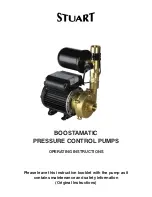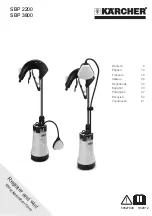
5
© Copyright 2013 Zoeller Co. All rights reserved.
DISASSEMBLY PROCEDURES,
continued
4. Tuck the motor leads and sensor wires into the center of the stator so they
will not be damaged when the stator is removed.
5. Turn the motor housing (17) over so that the bottom end is up. Hold the motor
stator (18) and lightly tap the housing flange with a soft hammer until the
stator comes out of the motor housing (17).
G. Removing sensor studs (35)...
1. Complete section A, section C #8, and section E #6.
2. Unscrew moisture sensors (35) from the adapter (34). The moisture sensor is
equipped with a resistor. The resistor must be cut free before unscrewing sensors.
Pumps are reassembled in reverse order of disassembly. The following suggestions
are offered.
NOTE: While the pump is dismantled, all gaskets, seal rings and retaining rings should
be checked for wear and deterioration. Replace all worn items. Ensure that all parts are
thoroughly cleaned before assembly.
A. Installing the sensor studs (35)...
1. Apply oil to threads of sensor studs (35).
2. Apply oil into threaded holes in adapter (34).
3. Screw sensor studs (35) into adapter (34). Apply 3.84 Nm (34 in-lbs) of torque.
4. Place resistor leads into sensor tubing and crimp tubing.
B. Assembly of rotor (27)...
1. Inspect rotor to see that the snap ring is in place and snapped in the groove.
This snap ring serves as a locator for the lower bearings.
2.
Install fan (28) and press on rotor shaft (27) until it seats against the rotor end ring.
Note that the fan blades are bent away from the rotor.
3. Slip the retaining ring (29) over the lower end of the shaft so that it rests next
to the fan.
NOTE: Before installing the bearing, wipe the bearing seats on the shaft clean and coat
the seats with oil to prevent galling of the shaft as the bearings are pressed onto the
shaft. A properly sized pressing sleeve should be used to install bearings, with pressure
being applied to only the inner bearing race.
4. Install the lower ball bearing (30) and the upper ball bearing (26) on the rotor shaft (27).
5. Set the adapter (34) on blocks to allow the rotor shaft to clear the work
surface when installed.
6. Install the rotor/bearings assembly into the adapter housing (34). Make sure
the lower bearing is seated in the bearing pocket.
7. Using a pair of 90° retaining ring pliers, install the retaining ring (29) into the
adapter (34) groove on top of the double row bearing (30).
C. Installing the motor spacer/stator (22 & 18)...
1. Install the motor (22) spacer into the motor housing (17). Make sure there is
no dirt in the housing.
2. With the motor housing (17) sitting bottom side up, coat the stator area of the
motor housing and the outside diameter of the stator (18) with oil.
3. Place the stator lead wires through the inside of the stator and pull them tight
against the end turn winding so that they are not cut by the motor spacers
(22) when the stator (18) is pressed into the motor housing (17).
4. While aligning the keyway in the stator (18) with the key slot in the motor
housing (17) install the stator (18) (motor leads first) by pressing into the
housing carefully so as not to damage any wires.
NOTE: A light press may be necessary for this step. Do not push on the windings of the stator.
5. Install the stator key (23) in the slot.
6. Install the three motor clips (21) and screws (20) using thread locking
compound on the screw threads.
7. Place the moisture sensor wires (31) through the wire chase between the
motor housing and stator. The sensor wires should hang out from the bottom
of the housing several inches.
D. Installing upper bearing housing (15) to motor housing (17)...
1. Pull motor leads through top of housing.
2. Lightly oil and position the seal ring (16) into groove in upper bearing housing
(15). Oil motor housing upper inside diameter at this time.
3. Suspend the upper bearing housing (15) over the motor housing (17) and
make wiring connections per proper wiring diagram and lead numbers.
NOTE: The motor leads go to the numbered terminals, the moisture sensor wires to
M1 and M2 and the thermosensor wires to T1 and T2.
4. Tuck the wires in so as not to damage them. Avoid getting them pinched or
near moving parts and lower into place on motor housing (17).
5. Aligning holes in upper bearing housing (15) and motor housing (17), press
upper bearing housing (15) into place making sure not to cut seal ring (16)
as unit is pressed into place.
6. Temporarily fasten the upper bearing housing to motor housing with a screw.
E. Installing the motor housing/stator on adapter/rotor...
1. Invert motor housing and tuck lead wires out of the way of any moving parts.
2. Lightly oil and position the seal ring (33) around the pilot shoulder of the
adapter
(34).
3. With the rotor/adapter assembly upright on blocks, suspend the motor
housing/stator unit over it.
4. Slowly lower the motor housing/stator unit down over the rotor aligning the
rotor and stator opening. Make sure not to let the rotor or any other parts
contact the stator windings so they will not be damaged. Lower the housing
until the moisture sensor wires (31) can be plugged onto the moisture sensors (35).
5. Tuck the moisture sensor wires away from the rotor while lowering the motor
housing/stator unit into place on the adapter.
6. Secure the motor housing/stator (17) to the adapter (34) with eight screws
(32) and lock washers (3). Torque to 19.77-22.03 Nm (175-195 in-lbs).
NOTE: The small arrowheads on the motor housing and adapter need to be approximately
aligned for proper orientation.
F. Installing cord and cover assembly...
NOTE: The cords will come from the factory as a cord and clamp assembly (6). The
assembly consists of the power cord, the sensor cord, the wire terminals, the clamp
and the potting compound between the cords and clamp.
1. Unroll the cords of the cord and clamp assembly (6) and slide the cord seal
(5) down the cords to the clamp.
2. From the inside of the cover (4) place the cords of the assembly (5 & 6)
through the holes and pull through the top.
3. Push the cord seal (5) into its pocket inside the cover (4). Push the clamp
tight against the seal (5).
4. Apply thread locker compounds to the screws (8) and install into clamp (6)
along with lock washers (7). Using a cross pattern, tighten the screws to the
seal clamp evenly. Torque screws to 13.56-14.69 Nm (120-130 in-lbs).
5. Apply thread locker compound to ground screw and install ground wires to cover (4).
6. Lightly oil and install seal ring (9) on shoulder of upper bearing housing (15).
7. Suspend the cord and cover assembly over the motor housing and make
wiring connections per the proper wiring diagram.
NOTE: The motor leads go to the numbered terminals, the moisture sensor wires to
M1 and M2 and the thermosensor wires to T1 and T2.
NOTE: If motor is dual voltage 230/460V 60 Hz, install jumper plates (13) and jumper
wire (14) on terminals (10) and secure with brass hex nuts (20) per proper wiring
connection diagram.
NOTE: If a temporary screw is holding the upper bearing housing to the motor housing,
remove it at this time.
8. Tuck the wires into the cover assembly as installing the cover into place.
9. Secure the cover (4) to the motor housing (17) with six screws (2) and six lock
washers (3). Torque screws to 19.77-22.03 Nm (175-195 in-lbs).
NOTE: The small arrowheads on the castings are to be aligned for proper orientation.
G. Installation of rotary seals and seal retainer...
CAUTION
Make sure all seal faces remain free of dirt particles. Apply a light
coat of oil to seal faces before installing.
1. Refer to rotary seal component placement diagram for relative positioning of
seal
parts.
2. Apply a coating of oil to the seal seat and the bore of the adapter (34), and
using a nonmetallic sleeve, press the seat into position in the adapter.
ASSEMBLY PROCEDURES


























